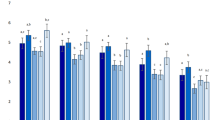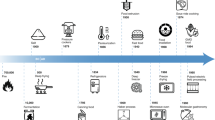Abstract
In this paper, dimensions of the debate surrounding the application of gene technology to food production are discussed and a study assessing perceptions of the technology among a sample of the UK public (n = 1499) is reported. The general picture that emerges from the study is one of people expressing low familiarity with the technology, with more people associating it with high risks than with low risks, and more people expecting it to provide low benefits than high benefits. Attitudes towards different applications vary significantly, as does trust in different potential sources of information about the technology. It is also shown that attitudes can be predicted not only by estimates of risks and benefits but also by perceptions of the involvement of ethical issues, by the perceived need for the technology, and by the perceived likelihood of improvements it is likely to bring to the quality of life in the UK. The results are discussed in the context of the need for greater public information about the technology and the realization that communication of risks takes place within a complex network of societal relationships.
Similar content being viewed by others
References
Johnson, G. L. and P. B. Thompson, 1991, “Ethics and values associated with agricultural biotechnology.” InAgricultural biotechnology: Issues and choices, edited by Bill R. Baumgardt and Marshall A. Martin (West Lafayette, IN: Purdue University Agricultural Experiment Station), pp. 127.
Brill, W.J., 1985, “Safety concerns and genetic engineering in agriculture.”Science, 227, 4685, 381–384.
Alexander, M., 1985, “Ecological consequences: Reducing the uncertainties.”Issues in Science and Technology, 1, 3, 57–68.
Hatchwell, P., 1989, “Opening Pandora's box: the risks of releasing genetically engineered organisms.”The Ecologist, 19, 4, 130–136.
Yeutter, C., 1991, “The politics of food and biotechnophobia.” InNew technologies and the future of food and nutrition, edited by G. E. Gaull and R. A. Goldberg (New York: John Wiley).
Comstock, G., 1988, “The case against bGH.”Agriculture and Human Values, 5, Summer, 36–52.
Levidow, L. and J. Tait, 1990, “The greening of biotechnology: From GMOs to environment-friendly products.” TPG Occasional Paper (Milton Keynes: Technology Policy Group: The Open University), pp. 2.
Plein, L. C., 1991, “Popularizing biotechnology: The influence of issue definition.”Science, Technology and Human Values, 16, 4, 474–490.
e.g. Bruhn, C.M., 1992, “Consumer concerns and educational strategies: Focus on biotechnology.”Food Technology, 46, 3, 80–97.
Beck, U., 1992, “From industrial society to risk society: Questions of survival, social structure and ecological enlightenment.” InCultural Theory and Cultural Change, edited by M. Featherstone (London: Sage).
Giddens, A., 1991,Modernity and self-identity: Self and society in late modern age (Cambridge: Polity Press), pp. 4.
Davis, B. D., 1987, “Bacterial domestication: Underlying assumptions.”Science, 235, 4794, 1329–1332.
Plein, L. C., 1991, “Popularizing biotechnology: The influence of issue definition.”Science, Technology and Human Values, 16, 4, 474–490.
ACOST, 1990,Developments in biotechnology (London: HMSO).
Straughan, R., 1991, “Genetic manipulation for food production: Social and ethical issues for consumers.”British Food Journal, 92, 7, 13–26.
Thompson, P. B., 1987, “Agricultural biotechnology and the rhetoric of risk: Some conceptual issues.”The Environmental Professional, 9, 316–326.
Harlander, S. K., 1991, “Social, moral, and ethical issues in food biotechnology.”Food Technology, 45, 5,152–161.
e.g. Alvensleben, R. V. and M Altmann, 1987, “Determinants of the demand for organic food in Germany.”Horticultural Economics, 203, 235–242.
Barber, B., 1983,The logic and limits of trust (New Brunswick, NJ: Rutgers University Press).
e.g. McGuire, W.J. 1985.Attitudes and attitude change. Handbook of social psychology(3rd edn, vol. 2), edited by G. Lindzey and E. Aronson (New York: Random House).
cf. Parsons, T., 1939, “The professions and social structure.”Social Forces, 17, 4, 457–467.
Marlier, E., 1992, “Eurobarometer 35.1: Opinions of Europeans on biotechnology.” InBiotechnology in public, edited by J. Durant (London: Science Museum), pp. 52–108.
OTA, 1987, “New developments in biotechnology.” Background paper 2: Public perceptions of biotechnology (US. Congressional Office of Technology Assessment).
Berrier, R. J., 1987, “Public perceptions of biotechnology.” InPublic perceptions of biotechnology, edited by L. R. Batra and W. Klassen (Bethesda, MD: Agricultural Research Institute).
Lacy, W. B., L. Busch, and L. P. Lacy, 1991, “Public perceptions of agricultural biotechnology.” InAgricultural biotechnology: issues and choices, edited by B.R. Baumgardt and M. A. Martin (West Lafayette, IN: Purdue University Agricultural Experiment Station).
Hamstra, A. M., 1991,Biotechnology in foodstuffs (Leiden: SWOKA).
e.g. Slovic, P., 1992, “Perceptions of risk: Reflections on the psychometric paradigm.” InSocial Theories of Risk, edited by S. Krimsky and D. Golding (Westport, CT: Greenwood).
Freudenburg, W.R., 1993, “Risk and recreancy: Weber, the division of labor, and the rationality of risk perceptions.”Social Forces, 71, 4, 909–932.
OPCS, 1980,Classification of occupations (London: HMSO).
Nielsen, 1992,The British Shopper 1992/93 (Henley: NTC Publications Ltd).
Hippler, H. J. and N. Schwarz, 1987, “Response effects in surveys.” InSocial information processing and survey methodology, edited by H.J.Hippler,N.Schwarz, and S. Sudman (New York: Springer).
cf. Tourangeau, R., R. A. Rasinski, Bradburn, and R. D'Andrade, 1991, “Carryover effects in attitude surveys.”Public Opinion Quarterly, 54 (3), 495–524.
Gaskell, G., D. Wright, and C. O'Muircheartaigh, 1993, “Measuring scientific interest: the effect of knowledge questions on interest ratings.”Public Understanding of Science, 2, 1, 39–57.
Martin, S. and J. Tait,, 1992, “Attitudes of selected public groups in the UK to biotechnology.” In Biotechnology in public, edited by J. Durant (London: Science Museum), pp. 28–41.
Hirschman, A. O., 1970,Exit, voice and loyalty: Responses to decline in firms, organizations and states (Cambridge, MA: Harvard University Press).
Slovic, P., 1987, “Perception of risk.”Science, 236, 4799, 280–285.
Johnson, G. L. and P. B. Thompson, 1991, “Ethics and values associated with agricultural biotechnology.” In Agricultural biotechnology: Issues and choices, edited by Bill R. Baumgardt and Marshall A. Martin (West Lafayette, IN: Purdue University Agricultural Experiment Station).
Sparks, P. and R. Shepherd, submitted. “Public perceptions of the potential hazards associated with food production and food consumption: Anempirical study.”
Johnson, G. L. and P. B. Thompson, 1991, “Ethics and values associated with agricultural biotechnology.” In Agricultural biotechnology: Issues and choices, edited by Bill R. Baumgardt and Marshall A. Martin (West Lafayette, IN: Purdue University Agricultural Experiment Station), pp. 134.
Thompson, P. B., 1987, “Agricultural biotechnology and the rhetoric of risk: Some conceptual issues.”The Environmental Professional, 9, 324.
Harlander, S. K., 1991, “Social, moral, and ethical issues in food biotechnology.”Food Technology, 45, 5, 152–161.
Additional information
Paul Sparks is a social psychologist at the Institute of Food Research, Reading, UK. He has studied at the Universities of Kent (BA) and Oxford (DPhil). His research interests include attitude theory, social influences on food choice, and social and moral dimensions of attitudes towards food consumption and food production methods.
Richard Shepherd graduated with an MA from Cambridge in Natural Sciences, followed by a B.Sc. from Cardiff in Psychology and a Ph.D. from Southampton in Psychology. He is currently Head of the Food Choice Section of the Consumer Sciences Department. His main current research interests are the application of psychological models of attitude and attitude change to food choice, consumer use of food label information, perception of risks associated with foods, and risk communication.
Lynn Frewer is a psychologist who has studied at the Universities of Bristol (B.Sc.), London (MSc) and Leeds (Ph.D.). Her interests include risk perception and attitudes, the role of the media in the transmission of risk information, and ethical concerns associated with emerging technologies.
Rights and permissions
About this article
Cite this article
Sparks, P., Shepherd, R. & Frewer, L.J. Gene technology, food production, and public opinion: A UK study. Agric Hum Values 11, 19–28 (1994). https://doi.org/10.1007/BF01534445
Issue Date:
DOI: https://doi.org/10.1007/BF01534445




